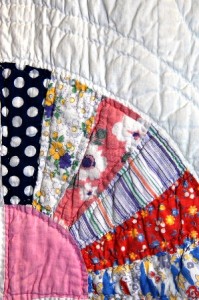By Holly Hanover
In any sewing project, uneven seams can make or break the final product. In quilting,  uneven seams result in a sloppy looking mess. When sewing blocks of fabric together, your entire pattern can be made moot due to uneven seams. There are many factors that affect the evenness of seams, and once you’re aware of them creating even and professional looking seams will be a breeze.
uneven seams result in a sloppy looking mess. When sewing blocks of fabric together, your entire pattern can be made moot due to uneven seams. There are many factors that affect the evenness of seams, and once you’re aware of them creating even and professional looking seams will be a breeze.
If uneven seams are threatening to become the bane of your existence by ruining all of your quilting projects, then follow these quilting instruction tips to end them forever:
- Learn to keep your eye on the raw edges of your fabric–and your stitch guide–as you sew. This is probably the most important aspect in sewing straight seams. Most seams should be ¼ inch from the needle. If you’re machine doesn’t have a stitch guide, create your own by measuring a piece of masking tape ¼’’ from the needle. Don’t use the edge of your presser foot as a guide as the widths of these vary.
- If your needle breaks while sewing, be sure to replace it with the same size needle. The difference may seem miniscule, but changing up the needle size in the middle of a project can result in uneven seams.
- When stitching two slightly uneven pieces of fabric, place the longer piece on the bottom and the shorter on top. The longer, bottom one should ease into the shorter piece as you sew.
- Make sure that your fabric is cut correctly. Using a rotary cutter, mat, and ruler is the best way to ensure uniform quilting pieces. Remember a golden rule of quilting instruction: measure twice and cut once!
- Backstitch all your seams so they stay together. Forgetting to do this could result in uneven seams at the corners.
- Thoroughly press all your seams using the proper temperature setting for your fabric. Press and do not iron, or push, the fabric. This could stretch it and result in uneven seam allowances.
- During the quilting process, the weight of the quilt itself can manipulate the fabric and cause uneven edges. This unsightly result can be kept at bay by either bunching up all your fabric on the table or surrounding your workspace with something, such as your ironing board, to bear the weight of the quilt as you sew.
- Lastly, always bear in mind that fabric is a fickle medium. It shrinks, stretches, or may have been made unevenly from the start. A basic lesson in quilting instruction is to always practice on scrap pieces so you’re prepared for however your machine may affect the fabric. Remember to sew slowly and observe the nature of the fabric you’re working with before attempting anything too complex.
Let us know what quilt project you are working on.

One Response to Quilt Project Tips: How to End Uneven Seams